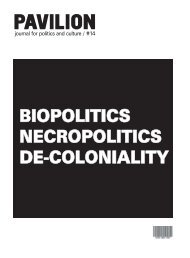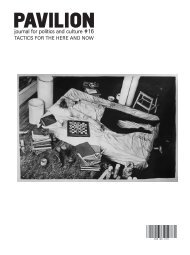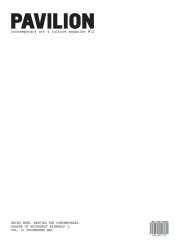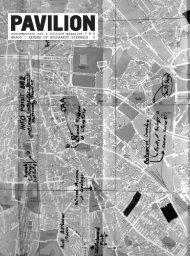PAVILION
PAVILION
PAVILION
- No tags were found...
Create successful ePaper yourself
Turn your PDF publications into a flip-book with our unique Google optimized e-Paper software.
Metamorphoses<br />
[72]<br />
by Antonio Negri<br />
To begin with, let us try, from a materialist<br />
standpoint, to situate historically the concept<br />
of plastic and figurative art in other<br />
words, the definition of its historically<br />
determinate link, if there is one, to the<br />
development and structure of modes of<br />
production. Can this be done? Obviously,<br />
once were obliged to speak of art and<br />
immaterial labour, this is a useful thing to<br />
do; in fact, its immaterial character does<br />
not strip labour not even in its relationship<br />
to artistic production of its historical centrality,<br />
and does not drain labouring activity<br />
of that economic energy and ontological<br />
power which must indeed exist in<br />
order for labour to be exploited under<br />
capitalism. So is such a definition possible?<br />
I think so. In fact (notwithstanding<br />
the superficiality and flimsiness of art<br />
markets that is, of artistic phenomena tied<br />
to the circulation of capital), we can outline<br />
a somewhat crude but nevertheless<br />
effective correspondence between the<br />
different epochs of artistic activity (styles<br />
and poetics), on the one hand, and the<br />
forms of capitalist production and organization<br />
of labour, on the other. In what follows,<br />
I would like to sketch out the figures<br />
taken by this relation.<br />
Let us go back, then, to the period that<br />
witnessed the increasing centrality of<br />
working-class struggle to capitalist development.<br />
From 1848 to 1870, this centrali-<br />
ty expresses itself with vigour in the massive<br />
growth and concentration of workingclass<br />
labour in all its materiality. Does the<br />
realism of artistic expression (between<br />
Courbet and Cézanne, for instance) display<br />
this new historical condition of work?<br />
I think it is possible to answer affirmatively<br />
if we consider the force with which the<br />
denaturalization of the real and the structural<br />
materiality of the subject begin to<br />
appear in this realism, precisely in correspondence<br />
with the first great episodes of<br />
industrial and metropolitan centralization<br />
in the exploitation of labour-power.<br />
The period of impressionism, between<br />
1871 and 1914, corresponds instead to<br />
policies on the side of the bosses that<br />
deepen the division of labour and its specialization<br />
policies to which there corresponds,<br />
on the workers side, a subversive<br />
project aiming at the self-management of<br />
production. We witness a first great<br />
episode in the emancipatory overdetermination<br />
by the professional worker of the<br />
conditions for the accumulation of capitalist<br />
production. Labour becomes aware of<br />
the fact that its enemy, the capitalist<br />
world, may be dissolved and possibly<br />
reconstructed if one grasps (that is, if one<br />
reappropriates) the key to production:<br />
labour itself, within the mode of production.<br />
It is in labour that the world is dissolved<br />
and reconstructed and possibly<br />
the artworld too. This is the slogan of this<br />
first phase of artistic transformation in the<br />
history of the present: creation consists in<br />
dissolution.<br />
Then comes the October Revolution. As<br />
the tsunami of revolutionary thought and<br />
subversive action spreads around the<br />
world; as capital, in order to respond to<br />
the challenge, finds itself obliged to<br />
enforce further proletarian growth and<br />
concentration in the productive base, to<br />
establish new norms of worker consumption<br />
(welfare), to push abstraction to the<br />
highest level, and to introduce scientific<br />
management into the organization of<br />
labour well, it is then that, in the aesthetic<br />
field too, the abstract form of artistic production<br />
prevails. This abstraction is at one<br />
and the same time the representation of<br />
the abstraction of labour and from the<br />
workers standpoint the material for an<br />
alternative imagination. What, in fact, is<br />
socialism if not the project autonomously<br />
to organize the abstraction of labour?<br />
From 1917 to 1929, from the storming of<br />
the Winter Palace to the Great Crisis, this<br />
is an expressionist abstraction, in the<br />
sense that it heroically defies the real and<br />
current determinations of exploitation<br />
while violently anticipating, aggressively<br />
advancing and seeking to overturn its<br />
degree of abstraction. This abstraction<br />
traverses the figurative, destroys and<br />
reconstructs it, experiencing revolutionary<br />
passion and the desire for a constructive<br />
aesthetics in epic excess.<br />
Then, having been led back to the market<br />
and the circulation of commodities,<br />
abstraction takes ever more analytical<br />
forms forms that remain abstract, but are<br />
precisely analytical, multifarious, sometimes<br />
ephemeral, often open to experimentation<br />
and to each of the innovations<br />
that the crisis (and the ensuing renewal of<br />
the capitalist mode of production) makes<br />
possible, and which the development of<br />
proletarian struggle demands. After 1929,<br />
the only artistic production is the one<br />
expressed by the mass-artist, embodied<br />
in his constructive capacity, as though<br />
artistic production constituted the form of<br />
this capacity. And this is the story which,<br />
amid constant experimentation, leads us<br />
all the way to 68. This is the period in<br />
which abstraction and production are<br />
intertwined: the abstraction of the current<br />
mode of production and the representation<br />
of possible worlds; the abstraction of<br />
the image and the use of the most varied<br />
[73]








